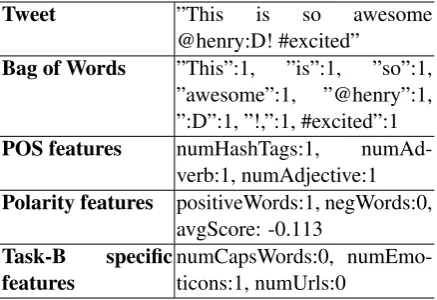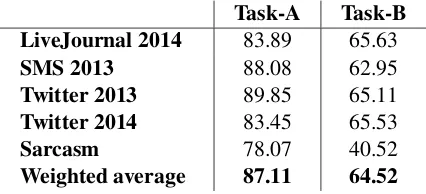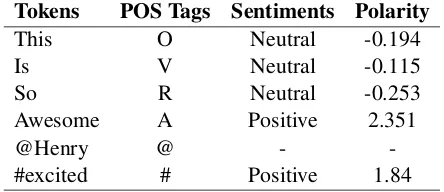CMUQ@Qatar:Using Rich Lexical Features for
Sentiment Analysis on Twitter
Sabih Bin Wasi, Rukhsar Neyaz, Houda Bouamor, Behrang Mohit
Carnegie Mellon University in Qatar
{sabih, rukhsar, hbouamor, behrang}@cmu.edu
Abstract
In this paper, we describe our system for the Sentiment Analysis of Twitter shared task in SemEval 2014. Our system uses an SVM classifier along with rich set of lexical features to detect the sentiment of a phrase within a tweet (Task-A) and also the sentiment of the whole tweet (Task-B). We start from the lexical features that were used in the 2013 shared tasks, we en-hance the underlying lexicon and also in-troduce new features. We focus our fea-ture engineering effort mainly on Task-A. Moreover, we adapt our initial frame-work and introduce new features for Task-B. Our system reaches weighted score of 87.11% in Task-A and 64.52% in Task-B. This places us in the 4th rank in the Task-A and 15th in the Task-B.
1 Introduction
With more than 500 million tweets sent per day, containing opinions and messages, Twitter1 has
become a gold-mine for organizations to monitor their brand reputation. As more and more users post about products and services they use, Twit-ter becomes a valuable source of people’s opin-ions and sentiments: what people can think about a product or a service, how positive they can be about it or what would people prefer the product to be like. Such data can be efficiently used for mar-keting. However, with the increasing amount of tweets posted on a daily basis, it is challenging and expensive to manually analyze them and locate the meaningful ones. There has been a body of re-cent work to automatically learn the public sen-This work is licensed under a Creative Commons At-tribution 4.0 International Licence. Page numbers and pro-ceedings footer are added by the organisers. Licence details: http://creativecommons.org/licenses/by/4.0/
1http://twitter.com
timents from tweets using natural language pro-cessing techniques (Pang and Lee, 2008; Jansen et al., 2009; Pak and Paroubek, 2010; Tang et al., 2014). However, the task of sentiment analysis of tweets in their free format is harder than that of any well-structured document. Tweet messages usu-ally contain different kinds of orthographic errors such as the use of special and decorative charac-ters, letter or word duplication, extra punctuation, as well as the use of special abbreviations.
In this paper, we present our machine learn-ing based system for sentiment analysis of Twitter shared task in SemEval 2014. Our system takes as input an arbitrary tweet and assigns it to one of the following classes that best reflects its sen-timent: positive, negative or neutral. While pos-itive and negative tweets are subjective, neutral class encompasses not only objective tweets but also subjective tweets that does not contain any ”polar” emotion. Our classifier was developed as an undergrad course project but later pursued as a research topic. Our training, development and testing experiments were performed on data sets published in SemEval 2013 (Nakov et al., 2013). Motivated with its performance, we participated in SemEval 2014 Task 9 (Rosenthal et al., 2014). Our approach includes an extensive usage of off-the-shelf resources that have been developed for conducting NLP on social media text. Our orig-inal aim was enhancement of the task-A. More-over, we adapted our framework and introduced new features for task-B and participated in both shared tasks. We reached an F-score of 83.3% in Task-A and an F-score of 65.57% in Task-B. That placed us in the 4th rank in the task-A and 15th rank in the task-B.
Our approach includes an extensive usage of off-the-shelf resources that have been developed for conducting NLP on social media text. That includes the Twitter Tokenizer and also the Twit-ter POS tagger, several sentiment analysis lexica
and finally our own enhanced resources for spe-cial handling of Twitter-specific text. Our origi-nal aim in introducing and evaluating many of the features was enhancement of the task-A. More-over, we adapted our framework and introduced new features for task-B and participated in both shared tasks. We reached an F-score of 83.3% in Task-A and an F-score of 65.57% in Task-B. That placed us in the 4th rank in the task-A and 15th rank in the task-B.
2 System Overview
We participate in tasks A and B. We use three-way classification framework in which we design and use a rich feature representation of the Twitter text. In order to process the tweets, we start with a pre-processing step, followed by feature extrac-tion and classifier training.
2.1 Data Pre-processing
Before the tweet is fed to the system, it goes through pre-processing phase that breaks tweet string into words (tokenization), attaches more in-formation to each word (POS tagging), and other treatments.
Tokenization: We use CMU ARK Tok-enizer (Owoputi et al., 2013) to tokenize each tweet. This tokenizer is developed to tokenize not only space-separated text but also tokens that need to be analyzed separately.
POS tagging: We use CMU ARK POS Tag-ger (Owoputi et al., 2013) to assign POS tags to the different tokens. In addition to the grammat-ical tags, this tagger assigns also twitter-specific tags like @ mentions, hash tags, etc. This infor-mation is used later for feature extraction.
Other processing: In order to normalize the dif-ferent tokens and convert them into a correct En-glish, we find acronyms in the text and add their expanded forms at the end of the list. We decide to keep both the acronym and the new word to en-sure that if the token without its expansion was the word the user meant, then we are not losing any information by getting its acronym. We ex-tend the NetLingo2top 50 Internet acronym list to
add some missing acronyms. In order to reduce in-flectional forms of a word to a common base form we use WordNetlemmatizer in NLTK (Bird et al.,
2http://www.netlingo.com/top50/
popular-text-terms.php
Tweet ”This is so awesome
@henry:D! #excited”
Bag of Words ”This”:1, ”is”:1, ”so”:1, ”awesome”:1, ”@henry”:1, ”:D”:1, ”!,”:1, #excited”:1 POS features numHashTags:1,
numAd-verb:1, numAdjective:1 Polarity features positiveWords:1, negWords:0,
avgScore: -0.113 Task-B specific
[image:2.595.310.529.62.212.2]features numCapsWords:0, numEmo-ticons:1, numUrls:0 Table 1: Set of Features demonstrated on a sample tweet for Task-B.
2009)3. This could be useful for the feature
extrac-tion, to get as much matches as possible between the train and test data (e.g., for bag-of-words fea-ture).
2.2 Feature Extraction
Assigning a sentiment to a single word, phrase or a full tweet message requires a rich set of fea-tures. For this, we adopt a forward selection ap-proach (Ladha and Deepa, 2011) to select the fea-tures that characterize to the best the different sen-timents and help distinguishing them. In this ap-proach, we incrementally add the features one by one and test whether this boosts the development results. We heavily rely on a binary feature rep-resentation (Heinly et al., 2012) to ensure the ef-ficiency and robustness of our classifier. The dif-ferent features used are illustrated in the example given in Table 1.
Bag-of-words feature: indicates whether a given token is present in the phrase.
Morpho-syntactic feature: we use the POS and twitter-specific tags extracted for each token. We count the number of adjectives, adverbs and hash-tags present in the focused part of the tweet mes-sage (entire tweet or phrase). We tried adding other POS based features (e.g., number of posses-sive pronouns, etc.), but only the aforementioned tags increased the result figures for both tasks. Polarity-based features: we use freely avail-able sentiment resources to explicitly define the polarity at a token-level. We define three feature categories, based on the lexicon used:
3http://www.nltk.org/api/nltk.stem.
Task-A Task-B
Dev Train Test Dev Train Test
Positive 57.09 % 62.06% 59.49% 34.76% 37.59% 39.01% Negative 37.89% 33.01% 35.31% 20.56% 15.06% 17.15%
Neutral 5.02% 4.93% 5.21% 44.68% 47.36% 43.84%
[image:3.595.99.502.61.147.2]All 1,135 9,451 10,681 1,654 9,684 8,987
Table 2: Class size distribution for all the three sets for both Task-A and Task-B.
• Subjectivity: number of words mapped to
”positive” from the MPQA Subjectivity lexi-con (Wilson et al., 2005).
• Hybrid Lexicon: We combine the
Senti-ment140 lexicon (Mohammad et al., 2013) with the Bing Liu’s bag of positive and neg-ative words (Hu and Liu, 2004) to create a dictionary in which each token is assigned a sentiment.
• Token weight: we use the SentiWordNet
lexicon (Baccianella et al., 2010) to define this feature. SentiWordNet contains positive, negative and objective scores between 0 and 1 for all senses in WordNet. Based on this sense level annotation, we first map each to-ken to its weight in this lexicon and then the sum of all these weights was used as the tweet weight.
Furthermore, in order to take into account the presence of negative words, which modify the po-larity of the context within which they are invoked, we reverse the polarity score of adjectives or ad-verbs that come within 1-2 token distance after a negative word.
Task specific features: In addition to the fea-tures described above, we also define some task-specific ones. For example, we indicate the num-ber of capital letters in the phrase as a feature in Task-A. This could help in this task, since we are focusing on short text. For Task-B we indicate instead the number of capital words. This relies on the intuition that polarized tweets would carry more (sometimes all) capital words than the neu-tral or objective ones. We also added the number of emoticons and number of URL links as fea-tures for Task-B. Here, the goal is to segregate fact-containing objective tweets from emotion-containing subjective tweets.
2.3 Classifier
We use a Support Vector Machine (SVM) classi-fier (Chang and Lin, 2011) to which we provide the rich set of features described in the previous section. We use a linear kernel and tune its param-eter C separately for the two tasks. Task-A sys-tem was bound tight to the development set with C=0.18 whereas in Task-B the system was given freedom by setting C=0.55. These values were optimized during the development using a brute-force mechanism.
Task-A Task-B LiveJournal 2014 83.89 65.63
SMS 2013 88.08 62.95
Twitter 2013 89.85 65.11
Twitter 2014 83.45 65.53
Sarcasm 78.07 40.52
Weighted average 87.11 64.52 Table 3: F1 measures and final results of the sys-tem for Task-A and Task-B for all the data sets including the weighted average of the sets.
3 Experiments and Results
[image:3.595.310.523.354.451.2]Task-A Task-B
all features 87.11 64.52
all-preprocessing 80.79(-6.32) 59.20(-5.32) all-ARK tokenization 83.69(-3.42) 60.61(-3.91) all-other treatments 85.06(-2.05) 62.19(-2.33) only BOW 81.69(-5.42) 57.85(-6.67) all-bow 82.05(-5.06) 52.04(-12.48)
all-pos 86.92(-0.19) 64.31(-0.21)
[image:4.595.163.440.61.240.2]all-polarity based features 81.80(-5.31) 57.95(-6.57) all-SVM tuning 80.82(-6.29) 21.41(-43.11) all-SVM c=0.01 84.20(-2.91) 59.87(-4.65) all-SVM c=selected 87.11(0.00) 64.52(0.00) all-SVM c=1 86.39(-0.72) 62.51(-2.01)
Table 4: F-scores obtained on the test sets with the specific feature removed.
The test dataset is composed of five differ-ent sets: Twitter2013 a set of tweets collected for the SemEval2013 test set,Twitter2014, tweets collected for this years version, LiveJournal2014
consisting of formal tweets, SMS2013, a collec-tion of sms messages,TwitterSarcasm, a collection of sarcastic tweets. The results of our system are shown in Table 3. The top five rows shows the results by the SemEval scorer for all the data sets used by them. This scorer took the average of F1-score of only positive and negative classes. The last row shows the weighted average score of all the scores for Task A and B from the different data sets.
Our scores for Task-A and Task-B were 83.45 and 65.53 respectively for Twitter 2014.
Our system performed better on Twitter and SMS test sets from 2013. This was reasonable since we tuned our system on these datasets. On the other hand, the system performed worst on sar-casm test set. This drop is extremely evident in Task-B where the results were dropped by 25%. To analyze the effects of each step of our sys-tem, we experimented with our system using dif-ferent configurations. The results are shown in Ta-ble 4 and our analysis is described in the following subsections. The results were scored by SemEval 2014 scorer and we took the weighted average of all data sets to accurately reflect the performance of our system.
We show the polarities values assigned to each token of a tweet by our classifier, in Table 5.
Tokens POS Tags Sentiments Polarity
This O Neutral -0.194
Is V Neutral -0.115
So R Neutral -0.253
Awesome A Positive 2.351
@Henry @ -
-#excited # Positive 1.84
Table 5: Polarity assigned using our classifier to each word of a Tweet message.
3.1 Preprocessing Effects
We compared the effects of basic tokenization (based on white space) against the richer ARK Twitter tokenizer. The scores dropped by 3.42% and 3.91% for Task-A and Task-B, respectively. Other preprocessing enhancements like lemmati-zation and acronym additions also gave our sys-tem performance a boost. Again, the effects were more visible for Task-B than for Task-A. Over-all, the system performance was boosted by 6.32% for Task-A and 5.32% for Task-B. Considering the overall score for Task-B, this is a significant change.
3.2 Feature Engineering Effects
[image:4.595.308.530.286.382.2]and social media representative lexicons are made, it would help both tasks significantly. POS based features were not directly influential in our system. However, these tags helped us find better matches in lexicons where words are further identified with their POS tag.
3.3 Classifier Tuning
We also analyzed the significance of SVM tuning to our system. Without setting any parameter to SVMutil library (Chang and Lin, 2011), we no-ticed a drop of 6.29% to scores of Task-A and a significant drop of 43.11% to scores of Task-B. Since the library use poly kernel by default, the results were drastically worse for Task-B due to large feature set. We also compared the perfor-mance with SVM kernel set to C=1. In this re-stricted setting, the results were slightly lower than the result obtained for our final system.
4 Discussion
During this work, we found that two improve-ments to our system would have yielded better scores. The first would be lexicons: Since the lexicons like Sentiment140 Lexicon are automati-cally generated, we found that they contain some noise. As we noticed a drop of that our results were critically dependent on these lexicons, this noise would have resulted in incorrect predictions. Hence, more accurate and larger lexicons are re-quired for better classification, especially for the tweet-level task. Unlike SentiWordNet these lexi-cons should contain more informal words that are common in social media. Additionally, as we can see our system was not able to confidently predict sarcasm tweets on both expression and message level, special attention is required to analyze the nature of sarcasm on Twitter and build a feature set that can capture the true sentiment of the tweet.
5 Conclusion
We demonstrated our classification system that could predict sentiment of an input tweet. Our system performed more accurately in expression-level prediction than on entire tweet-expression-level predic-tion. Our system relied heavily on bag-of-words feature and polarity based features which in turn relied on correct part-of-speech tagging and third-party lexicons. With this system, we ranked 4th in SemEval 2014 expression-level prediction task and 15th in tweet-level prediction task.
Acknowledgment
We would like to thank Kemal Oflazer and the shared task organizers for their support through-out this work.
References
Stefano Baccianella, Andrea Esuli, and Fabrizio Sebas-tiani. 2010. SentiWordNet 3.0: An Enhanced Lex-ical Resource for Sentiment Analysis and Opinion Mining. In Proceedings of the Seventh conference on International Language Resources and Evalua-tion (LREC’10), pages 2200–2204, Valletta, Malta.
Steven Bird, Ewan Klein, and Edward Loper. 2009. Natural Language Processing with Python. O’Reilly Media, Inc.
Chih-Chung Chang and Chih-Jen Lin. 2011. LIB-SVM: A Library for Support Vector Machines. ACM Transactions on Intelligent Systems and Tech-nology, 2:27:1–27:27.
Jared Heinly, Enrique Dunn, and Jan-Michael Frahm. 2012. Comparative Evaluation of Binary Features. InProceedings of the 12th European Conference on Computer Vision, pages 759–773, Firenze, Italy.
Minqing Hu and Bing Liu. 2004. Mining and Sum-marizing Customer Reviews. InProceedings of the Tenth ACM SIGKDD International Conference on Knowledge Discovery and Data Mining, pages 168– 177, Seattle, WA, USA.
Bernard J Jansen, Mimi Zhang, Kate Sobel, and Ab-dur ChowAb-dury. 2009. Twitter Power: Tweets as Electronic Word of Mouth. Journal of the Ameri-can society for information science and technology, 60(11):2169–2188.
L. Ladha and T. Deepa. 2011. Feature Selection Meth-ods and Algorithms. International Journal on Com-puter Science and Engineering (IJCSE), 3:1787– 1797.
Saif Mohammad, Svetlana Kiritchenko, and Xiaodan Zhu. 2013. NRC-Canada: Building the State-of-the-Art in Sentiment Analysis of Tweets. InSecond Joint Conference on Lexical and Computational Se-mantics (*SEM), Volume 2: Proceedings of the Sev-enth International Workshop on Semantic Evalua-tion (SemEval 2013), pages 321–327, Atlanta, Geor-gia, USA.
Olutobi Owoputi, Brendan O’Connor, Chris Dyer, Kevin Gimpel, Nathan Schneider, and Noah A. Smith. 2013. Improved Part-of-Speech Tagging for Online Conversational Text with Word Clusters. In Proceedings of the 2013 Conference of the North American Chapter of the Association for Computa-tional Linguistics: Human Language Technologies, pages 380–390, Atlanta, Georgia.
Alexander Pak and Patrick Paroubek. 2010. Twitter as a Corpus for Sentiment Analysis and Opinion Min-ing. In Proceedings of the Seventh conference on International Language Resources and Evaluation (LREC’10), pages 1320–1326, Valletta, Malta. Bo Pang and Lillian Lee. 2008. Opinion Mining and
Sentiment Analysis, volume 2. Now Publishers Inc. Sara Rosenthal, Preslav Nakov, Alan Ritter, and
Veselin Stoyanov. 2014. SemEval-2014 Task 9: Sentiment Analysis in Twitter. InProceedings of the Eighth International Workshop on Semantic Evalu-ation (SemEval’14), Dublin, Ireland.
Duyu Tang, Furu Wei, Nan Yang, Ming Zhou, Ting Liu, and Bing Qin. 2014. Learning Sentiment-Specific Word Embedding for Twitter Sentiment Classification. InProceedings of the 52nd Annual Meeting of the Association for Computational Lin-guistics, pages 1555–1565, Baltimore, Maryland. Theresa Wilson, Janyce Wiebe, and Paul Hoffmann.


